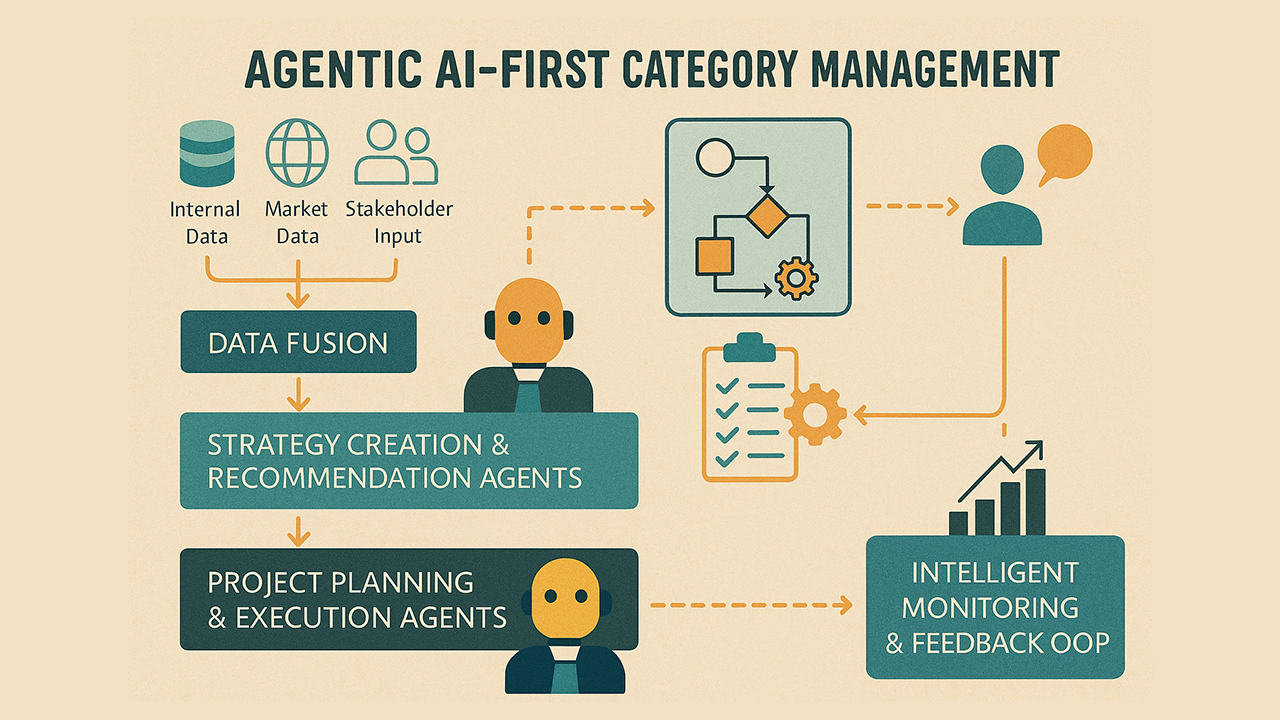The False Comfort of Control: Dashboards Aren’t Strategy
For over a decade, category management has been buried in dashboards, spreadsheets, and fragmented tools—giving procurement teams the illusion of control. But in today’s evolving landscape, AI agents for category management procurement are emerging as the solution to move beyond passive observation. Sure, you can slice spend data twelve different ways. You can overlay market intelligence. You can create PowerPoint slides that tell a good story.
But here’s the uncomfortable truth backed by recent research: dashboards don’t drive decisions. People do. And according to McKinsey’s 2024 State of AI report, only 78% of organizations use AI in at least one business function, with procurement lagging behind IT and marketing—while procurement teams struggle with data accuracy and stakeholder confidence issues.
- What if your category strategies weren’t static PowerPoints but living, evolving organisms?
- What if instead of “monitoring” risk, you had autonomous agents that acted on it?
It’s time to leave behind the comfort of observation—and move toward Agentic AI, where intelligent systems don’t just inform procurement decisions… they drive them.
Why Category Management is Failing Its Promise: The Data Behind the Crisis
The numbers are telling a brutal story. While Gartner’s latest data shows 100% of leaders measure cost savings, only a minority measure innovation, ESG impact, or business alignment. That’s not leadership—that’s cost chasing.
But the real crisis runs deeper. The 2025 ProcureCon Chief Procurement Officer Report reveals that 62% of CPOs said procurement ROI had either stayed the same or worsened over the past 12 months, despite 64% reporting improved maverick spending controls.
Category managers are overwhelmed and drowning in tactical work. According to recent WBR Insights research of 100 procurement leaders, they’re expected to:
- Track supply risk in volatile markets (52% use AI for supplier risk management, but satisfaction rates remain low)
- Align with ESG goals and stakeholder needs (67% of CSCOs are now accountable for environmental and social sustainability KPIs)
- Stay on top of projects, sourcing events, and supplier disruptions
- Drive innovation across global supply chains
All while working in Excel hell and outdated BI tools that provide visibility without velocity.
Let’s call this what it is: strategic theater. Impressive on slides, ineffective in execution. The Art of Procurement’s 2025 State of AI report confirms that only 36% of procurement organizations have meaningful generative AI implementations, despite 94% of procurement executives using GenAI tools weekly.
Enter Agentic AI: The Category Manager That Never Sleeps
Agentic AI doesn’t just analyze. It observes, plans, acts, and learns.
Unlike co-pilot-style GenAI that requires human prompts, Agentic AI systems can be tasked with goals and autonomously execute multi-step workflows across sourcing, contracting, intake, and stakeholder engagement. Gartner predicts that by 2027, 50% of procurement tasks will be automated by AI agents, and expects 33% of enterprise software applications will include agentic AI by 2028—a massive uptick from less than 1% in 2024.
Download Whitepaper: Procurement OS 4.0: The Future of Category Management
The difference is profound: while traditional automation follows preset rules, AI agents think strategically, learn from experience, and make complex decisions autonomously— like comparing a calculator to a chess grandmaster.
Imagine this scenario playing out in real-time:
- Your Category AI detects an emerging geopolitical risk in a supplier region
- It automatically simulates the impact using market intelligence and historical patterns
- It proposes alternative sourcing plans with cost-benefit analysis
- It notifies stakeholders via MS Teams with rationale and executes a mitigation plan via your S2P suite
- It learns from the outcome to improve future responses
No meetings. No lag. Just decisions. At speed.
Read more: Category Management Is Trapped in Silos- How Agentic AI Will Finally Connect Your S2P Intelligence
The Architecture of Agentic Category Management
At Zycus, we’ve architected what this new category management stack looks like, built on four foundational layers:
1. Data Fusion Layer
Ingest internal (spend, contract, performance) and external (market, ESG, risk) data in real-time. The global AI in procurement market is projected to reach $22.6 billion by 2033, growing at a 28.1% CAGR, driven by organizations demanding unified data visibility.
2. Strategy Creation Agents
Use AI planners to simulate category strategies aligned to risk, cost, ESG, and stakeholder goals. These agents don’t just recommend—they continuously adapt strategies based on market conditions and performance data.
3. Project Execution Agents
Orchestrate sourcing events, policy compliance, and milestone tracking autonomously. Companies like Walmart and Maersk are already deploying AI agents that complete negotiation cycles in minutes rather than weeks, with value generation typically ranging from 2-30% on negotiated spend.
4. Intelligent Feedback Loops
Track results in real time and adjust strategies dynamically. This creates continuous learning systems that become more effective with each interaction.
This is not a dashboard. It’s a cockpit for autonomous value creation.
The Competitive Reality: Early Movers Are Already Winning
While you wait for the next dashboard upgrade or Excel macro to break, early movers are delivering transformational results:
Speed & Scale:
- Executing 3x more category initiatives in the same time through autonomous workflow orchestration
- Reducing cycle times for RFx, negotiation, and onboarding by weeks through intelligent automation
Risk & Intelligence:
- Identifying risks 40% faster and acting before competitors through predictive analytics
- Achieving up to 25% improvements in productivity and effectiveness in pilot programs (The Hackett Group, 2024)
Financial Impact:
- Companies using AI-driven negotiation consistently report significant cost savings: one major financial services provider delivered $40 million in savings across $300 million of spend under management
- Organizations experience better visibility into procurement processes with 63% reporting improved transparency through AI implementation
According to Deloitte’s 2024 CPO Survey, 92% of CPOs are planning and assessing Generative AI capabilities, yet only 37% were piloting or deploying at the time of survey. This massive gap represents both risk and opportunity.
Where to Begin: Your Roadmap to Agentic Category Management
Audit your current tools:
Are they static, reactive, and human-dependent? The research shows that 76% of organizations use generative AI for category management—but most are still in experimental phases.
Identify agent-ready tasks:
Start with repetitive sourcing events, stakeholder intake, and risk tracking. 77% of organizations use AI for market intelligence gathering, making this a natural starting point.
Partner with AI-native providers:
Not just for analytics, but for orchestration and autonomy. Look for platforms like Zycus that offer true agentic capabilities, not just GenAI wrappers. Explore Zycus’ Merlin Agentic AI Platform for autonomous procurement workflows.
Design for adaptation:
Category strategies must evolve weekly, not annually. 95% of supply chains must quickly react to change, but only 7% can execute decisions in real time—agentic AI bridges this execution gap.
The Future Isn’t a Dashboard. It’s a Decision-Making Engine.
The data is unequivocal: 63% of procurement organizations fear losing their competitive advantage if their use of data and analytics doesn’t improve (Gartner’s Procurement Predicts 2025). The window for transformation is closing rapidly.
Agentic AI won’t replace your category managers. It will augment them into strategic commanders, armed with real-time intelligence, automated execution, and adaptive strategy. While humans provide context, ethical judgment, and creativity, AI agents provide speed, precision, and the ability to scale decision-making across millions of data points.
If the last decade was about visibility, the next will be about velocity and value.
The organizations that understand this shift—from passive analytics to proactive, autonomous intelligence—will define the next generation of category management. The question isn’t whether this transformation will happen. It’s whether you’ll lead it or follow it.
Ready to transform your category management strategy? Discover how Zycus’ Agentic AI for Category Management solutions can turn your procurement function into a strategic advantage.
Zycus is building the first Agentic AI–powered category management ecosystem. With over 10 years of AI innovation in procurement and a comprehensive Source-to-Pay platform that balances autonomy with control, we’re enabling organizations to harness AI while maintaining oversight of the entire process. Explore our autonomous negotiation agents, intelligent contract management, and AI-powered spend analytics solutions. If you’re ready to lead the change instead of follow it, let’s talk.
Related Reads:
- The Future Of Category Management Is Here!
- Why Yesterday’s Data Creates Tomorrow’s Disasters: The Category Intelligence Crisis
- 8 Key Stages of Category Management Process: A Sneak Peek
- Harnessing Generative AI for Revolutionary Category Strategy Development in Procurement
- Solution: Agentic AI for Category Management
- Catalyzing Success with Supplier Management Strategies in 2024
- The Stages of Strategic eSourcing: A Comprehensive Guide
- Mastering Change Management in E-Procurement Software Implementation: Best Practices
- A Comprehensive Guide to Spend Management
- The Growing Significance of Intake to Procure Management Soaring in Procurement








































